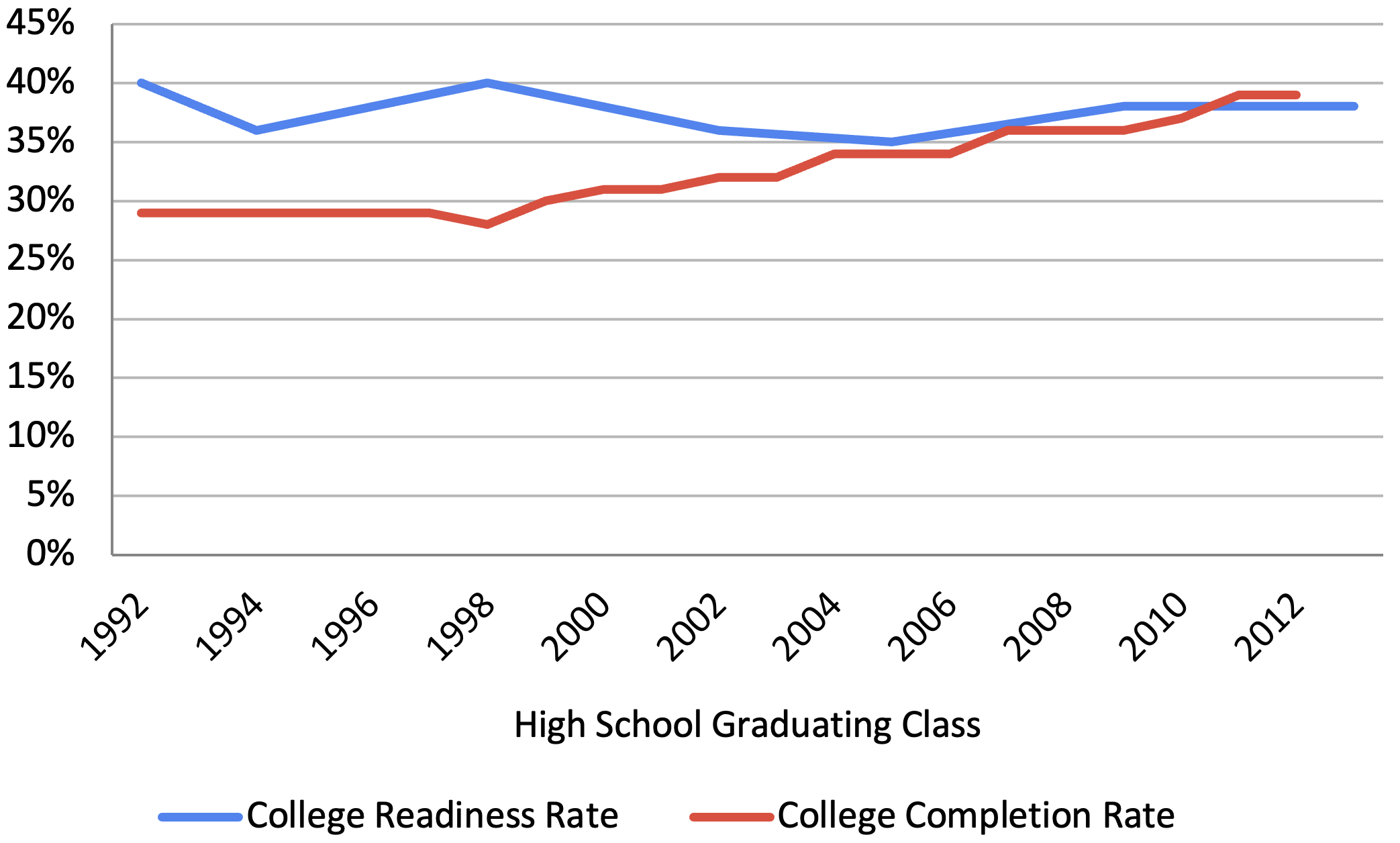
One of the biggest shifts in education reform in recent years has been widening acknowledgment that the “college for all” mantra was misguided. Almost everyone now admits that college, as traditionally defined, is not going to be for everyone, and that career and technical programs and trade schools can provide sturdy on-ramps to the middle class.
Yet so far our commitment to “multiple pathways” to opportunity is almost all talk accompanied by very little action. Those of us in and around K–12 education continue to behave as if virtually every student is expected to go off to a four-year university. That’s especially the case when it comes to:
- High school course requirements. These policies may have more on-the-ground traction than any others in education, yet they get almost no attention. They should because they remain stuck in the college-for-all mindset. According to the Education Commission of the States (ECS), of the forty-seven jurisdictions that set these requirements at the state level, forty-six require four years of English, forty-two require three years of math, forty require three years of social studies, and thirty-six require three years of science. Not to mention requirements for health, physical education, and fine arts. How are students supposed to take career and technical programs, do on-the-job training, or tackle apprenticeships when their schedules are already full of mandatory academic courses?
- High school course-taking. Not surprisingly, given states’ graduation requirements, students’ course loads remain overwhelmingly academic—even more so than in the past. According to the latest Digest of Education Statistics, public high school graduates in the class of 2009 earned, on average, 4.4 Carnegie units of English, 4.2 units of social studies or history, 3.9 units of math, 3.5 units of science, 2.2 units of foreign language, and 2.1 units of art. Compare that to 3.9, 3.2, 2.7, 2.2, 1.0, and 1.5, respectively, for the high school graduating class of 1980. Meanwhile, just since 2000 (when statisticians started collecting the data), the number of career and technical education credits obtained by the average public high school graduate declined from 2.9 to 2.5. So the class of 2009 earned more than eight academic credits for every one credit of CTE. That says to me that virtually all students are in fact in a college-prep program, maybe with a little CTE on the side.
Table 1. Average number of academic Carnegie units earned by the graduating classes of 1980 and 2009 (Source: Digest of Education Statistics)
| Class year | English | Social studies | Math | Science | Foreign language | Art | Total |
| 1980 | 3.9 | 3.2 | 2.7 | 2.2 | 1.0 | 1.5 | 14.5 |
| 2009 | 4.4 | 4.2 | 3.9 | 3.5 | 2.2 | 2.1 | 20.3 |
- High school testing and accountability systems. According to another analysis by ECS, “about” twenty-two states use a college entrance exam as their high school accountability test (either the ACT, SAT, or PSAT)—exams that are of little use to students heading into the trades. State accountability metrics tend to focus heavily on high school graduation rates—themselves tied to those academically-oriented course requirements—as well as college-and-career-ready indicators that strongly emphasize student success in various forms of post-secondary education rather than the labor market. In many states, for example, high schools get credit for sending their students on to college, but no credit for helping graduates earn a living wage.
These policies reflect the reality that our education system—and education reformers—remain uncomfortable with separate high school tracks for students with different goals, skill sets, and academic backgrounds. Thus we promote college and career instead of college or career.
We do so for understandable reasons. We remember the old vo-tech system, which was rightly criticized as racist, classist, and sexist. Too often, school systems in the bad old days selected students to “work with their hands” based on their skin color or zip code, rather than a sophisticated assessment of their strengths, proclivities, and goals. We want college prep to be the default, lest academically promising students from the wrong side of the tracks fail to enroll in the right classes and fulfill their potential. Plus, we Americans love the idea of second (and third, and fourth) chances, never wanting to “give up” on people if we think they have a chance to “make it.”
But that thinking still reflects a college bias, perhaps hard-wired into educators and reformers who themselves graduated from four-year colleges. It assumes that college is better than the trades, or middle-skill jobs, or plain old work experience—and that kids should only “settle” for these options after giving college the, well, old college try. That’s one reason we see so many people bemoaning the fact that college-going has plummeted during the pandemic.
If we really believe that Americans without college degrees are just as valuable to our society, democracy, and economy; just as worthy of dignity; and just as worthy of respect as us over-credentialed professionals, then we should stop telling our young people that college is the only goal worth shooting for. We should be willing to be more honest, to say that college is a great option for people who like school and are good at it. That group is probably about 40 percent of high school graduates, give or take, judging by college-readiness and college-graduation rates of late. And in light of the pandemic and massive learning loss, we’ll be lucky if that number doesn’t decline, at least in the short term.
Figure 1. College readiness rate versus college completion rate, by high school graduating class, 1992–2012

Note: In reading, the National Assessment Government Board estimates that “college-prepared” is equivalent to “NAEP-proficient.” So these numbers are the percentage of all twelfth-grade students who were proficient in reading in the years shown. Bachelor’s degree completion numbers come from the National Center for Education Statistics’ Digest of Education Statistics, Table 104.20: “Percentage of persons twenty-five to twenty-nine years old with selected levels of educational attainment, by race/ethnicity and sex: Selected years, 1920 through 2020.”
For people who aren’t academic superstars but have other strengths and interests, a trade or the like might be a better fit. Individuals only benefit from the “college wage premium” if they actually complete college, and that is unlikely for people who leave high school without college-ready skills in reading, writing, and mathematics. And as recent studies have shown, more education doesn’t always equate to more earnings.
Yet today, thanks to state high school graduation requirements and school accountability systems, we only give kids time to take a few CTE courses as electives. Instead, we should embrace models from Germany, Switzerland, and Austria, where many sixteen- and seventeen-year-olds spend most, if not all, of their time in apprenticeships, at workplaces, while finishing coursework that purposefully connects academics to technical skills. We might, in other words, allow students to choose to finish their core academic courses after their sophomore year, and spend junior and senior years getting ready for the real world, as Maryland’s Kirwan Commission recommended. And if we stop fetishizing college degrees, we might even help to stem the populist backlash against meritocracy that is shaking our society and our politics.
We talk a good game on career and technical education and the “dignity of work.” It’s time for us to walk the walk, too.
Michael J. Petrilli is president of the Thomas B. Fordham Institute, visiting fellow at Stanford University’s Hoover Institution, and an executive editor of Education Next.
This post originally appeared on the Fordham Institute’s Flypaper blog.


